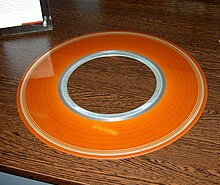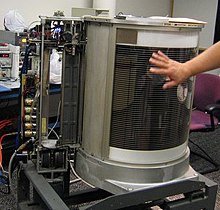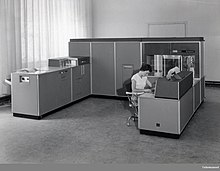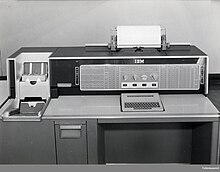
In a computer's central processing unit (CPU), the accumulator is a register in which intermediate arithmetic logic unit results are stored.

The Data General Nova is a series of 16-bit minicomputers released by the American company Data General. The Nova family was very popular in the 1970s and ultimately sold tens of thousands of units.

The IBM System/360 (S/360) is a family of mainframe computer systems that was announced by IBM on April 7, 1964, and delivered between 1965 and 1978. It was the first family of computers designed to cover both commercial and scientific applications and a complete range of applications from small to large. The design distinguished between architecture and implementation, allowing IBM to release a suite of compatible designs at different prices. All but the only partially compatible Model 44 and the most expensive systems use microcode to implement the instruction set, featuring 8-bit byte addressing and binary, decimal and hexadecimal floating-point calculations.

In computing, booting is the process of starting a computer as initiated via hardware such as a button or by a software command. After it is switched on, a computer's central processing unit (CPU) has no software in its main memory, so some process must load software into memory before it can be executed. This may be done by hardware or firmware in the CPU, or by a separate processor in the computer system.
The Honeywell 6000 series computers were rebadged versions of General Electric's 600-series mainframes manufactured by Honeywell International, Inc. from 1970 to 1989. Honeywell acquired the line when it purchased GE's computer division in 1970 and continued to develop them under a variety of names for many years. In 1989, Honeywell sold its computer division to the French company Groupe Bull who continued to market compatible machines.

The IBM 1620 was announced by IBM on October 21, 1959, and marketed as an inexpensive scientific computer. After a total production of about two thousand machines, it was withdrawn on November 19, 1970. Modified versions of the 1620 were used as the CPU of the IBM 1710 and IBM 1720 Industrial Process Control Systems.

The IBM 650 Magnetic Drum Data-Processing Machine is an early digital computer produced by IBM in the mid-1950s. It was the first mass produced computer in the world. Almost 2,000 systems were produced, the last in 1962, and it was the first computer to make a meaningful profit. The first one was installed in late 1954 and it was the most-popular computer of the 1950s.

The IBM 709 was a computer system, initially announced by IBM in January 1957 and first installed during August 1958. The 709 was an improved version of its predecessor, the IBM 704, and was the third of the IBM 700/7000 series of scientific computers. The improvements included overlapped input/output, indirect addressing, and three "convert" instructions which provided support for decimal arithmetic, leading zero suppression, and several other operations. The 709 had 32,768 words of 36-bit magnetic core memory and could execute 42,000 add or subtract instructions per second. It could multiply two 36-bit integers at a rate of 5000 per second.

The IBM 700/7000 series is a series of large-scale (mainframe) computer systems that were made by IBM through the 1950s and early 1960s. The series includes several different, incompatible processor architectures. The 700s use vacuum-tube logic and were made obsolete by the introduction of the transistorized 7000s. The 7000s, in turn, were eventually replaced with System/360, which was announced in 1964. However the 360/65, the first 360 powerful enough to replace 7000s, did not become available until November 1965. Early problems with OS/360 and the high cost of converting software kept many 7000s in service for years afterward.
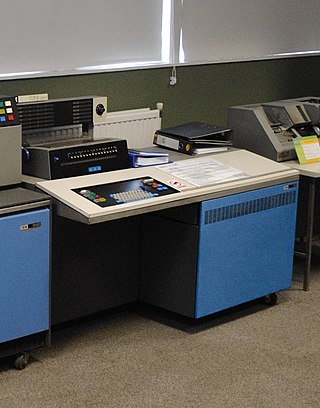
The IBM 1130 Computing System, introduced in 1965, was IBM's least expensive computer at that time. A binary 16-bit machine, it was marketed to price-sensitive, computing-intensive technical markets, like education and engineering, succeeding the decimal IBM 1620 in that market segment. Typical installations included a 1 megabyte disk drive that stored the operating system, compilers and object programs, with program source generated and maintained on punched cards. Fortran was the most common programming language used, but several others, including APL, were available.
Addressing modes are an aspect of the instruction set architecture in most central processing unit (CPU) designs. The various addressing modes that are defined in a given instruction set architecture define how the machine language instructions in that architecture identify the operand(s) of each instruction. An addressing mode specifies how to calculate the effective memory address of an operand by using information held in registers and/or constants contained within a machine instruction or elsewhere.
IBM manufactured magnetic disk storage devices from 1956 to 2003, when it sold its hard disk drive business to Hitachi. Both the hard disk drive (HDD) and floppy disk drive (FDD) were invented by IBM and as such IBM's employees were responsible for many of the innovations in these products and their technologies. The basic mechanical arrangement of hard disk drives has not changed since the IBM 1301. Disk drive performance and characteristics are measured by the same standards now as they were in the 1950s. Few products in history have enjoyed such spectacular declines in cost and physical size along with equally dramatic improvements in capacity and performance.

The IBM System/3 was an IBM midrange computer introduced in 1969, and marketed until 1985. It was produced by IBM Rochester in Minnesota as a low-end business computer aimed at smaller organizations that still used IBM 1400 series computers or unit record equipment. The first member of what IBM refers to as their "midrange" line, it also introduced the RPG II programming language. It is the first ancestor in the product line whose current version is the IBM i series and includes the highly successful AS/400.
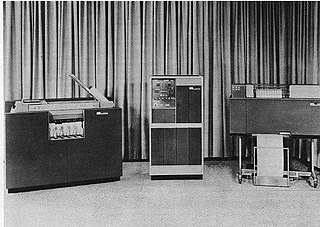
The IBM 1400 series were second-generation (transistor) mid-range business decimal computers that IBM marketed in the early 1960s. The computers were offered to replace tabulating machines like the IBM 407. The 1400-series machines stored information in magnetic cores as variable-length character strings separated on the left by a special bit, called a "wordmark," and on the right by a "record mark." Arithmetic was performed digit-by-digit. Input and output support included punched card, magnetic tape, and high-speed line printers. Disk storage was also available.
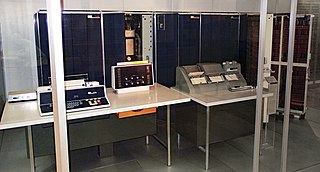
IBM 7070 is a decimal-architecture intermediate data-processing system that was introduced by IBM in 1958. It was part of the IBM 700/7000 series, and was based on discrete transistors rather than the vacuum tubes of the 1950s. It was the company's first transistorized stored-program computer.

CER model 12 was a third-generation digital computer developed by Mihajlo Pupin Institute (Serbia) in 1971 and intended for "business and statistical data processing". However, the manufacturer also stated, at the time, that having in mind its architecture and performance, it can also be used successfully in solving "wide array of scientific and technical issues". Computer CER-12 consisted of multiple modules connected via wire wrap and connectors.
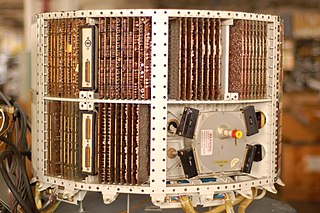
The D-17B (D17B) computer was used in the Minuteman I NS-1OQ missile guidance system. The complete guidance system contained a D-17B computer, the associated stable platform, and power supplies.
This timeline of binary prefixes lists events in the history of the evolution, development, and use of units of measure which are germane to the definition of the binary prefixes by the International Electrotechnical Commission (IEC) in 1998, used primarily with units of information such as the bit and the byte.
William A. Goddard was an American engineer and inventor. He earned a degree in physics from Occidental College. Before working in industry, Goddard was a high school science teacher in Los Angeles. He briefly worked in the aerospace industry for North American Aviation, Inc. before becoming an engineer at International Business Machines (IBM). His most acclaimed achievement is co-inventing along with John Lynott United States Patent 3,503,060, which is entitled “Direct Access Magnetic Disc Storage Device”. This invention claims cover modern-day hard disk drives.
ICT 1900 was a family of mainframe computers released by International Computers and Tabulators (ICT) and later International Computers Limited (ICL) during the 1960s and 1970s. The 1900 series was notable for being one of the few non-American competitors to the IBM System/360, enjoying significant success in the European and British Commonwealth markets.


